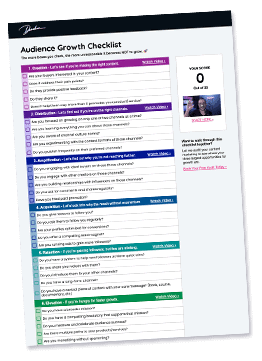If you own a nonprofit, you know the painstaking commitment to hard work that must be made to seek out donors. While most nonprofits need to raise money, they go about it differently depending on what marketing strategy works best for their nonprofit. Do you know what techniques are the most effective for your nonprofit’s category?
What is the right type of marketing for your nonprofit? To market your nonprofit, you need to understand your message, target your audience, and consider where that specific demographic would receive maximum exposure to your campaign. All marketing campaigns should be consistent across all channels, diversifying their promotion through digital and nondigital means.
If you’re always looking for unique ways to market to prospects, don’t feel like you need to have a huge budget to be successful. This list is all about giving your nonprofit tips to thrive and grow! Here’s a compilation of the best marketing techniques for every nonprofit.
Choose The Right Type of Marketing for Your Nonprofit
We’ve all seen the advertisements and promotional content that works beautifully. ‘The Most Interesting Man in the World,’ campaign, ‘Share a coke,’ ‘Got Milk?”
Get The Audience Growth Checklist 🚀
Your content deserves an audience. Find out how to get the reach it deserves.
What all of these have in common is that the marketers took a catchy and unique tagline and then spread it across all digital and non-digital marketing streams.
The best marketers can take a concept for their business, or in this case – your nonprofit, and connect it in a memorable, unique way.
We will go through each type of major charity and nonprofit section and then cover what all of them should have in common to be at their most effective.
Animal Nonprofits
The greatest success for nonprofits is when you’re able to combine the following to get the most donations and adoptions:

- Compelling images
- Concise copy and text
- A direct system to donate or adopt that doesn’t take much time
- Branding consistently across all marketing channels
Let’s look at a few examples:
The Nevada Humane Society is always coming up with funny ways to capture attention. Their campaigns work because they tug at heartstrings and appeal to how animals are so cute and funny. They educate while offering community support and spread their campaigns across the channels of:
- All social media platforms (hashtags added for Instagram, targeting on Facebook to the most likely donors, twitter posts multiple times a day during the peak of the campaign)
- Email – Following up on the impact in their newsletter
- Video content on YouTube
- Their website
Then following up with later reports of the success stories, a number of adoptions, or effect of the donations. Showing that their money is helping bring about change is one of the most essential parts of a campaign. If people see the good work you’re doing, they will be more inclined to donate or be a recurring donor.
SPCA in Charlottesville Albemarle is another foundation that has great success with their video campaigns, and their website makes it easy to see precisely where to submit donations. You always want to include a call-to-action on any platform and ask for that donation. If you don’t ask, you’ll never receive it.
The balance in marketing for an Animal nonprofit is to show the hardships these animals are facing and the severity of the problem through compelling images, while also having fun with your subject. People love how silly animals are, so if you can reach their hearts while sometimes making them laugh, you’ll be marketing to the fullest of your potential.
Here are a couple of great resources for shelters and animal nonprofits to utilize:
Educational Nonprofits
Educational charities serve students at every age to make education more accessible to all demographics and also higher quality.

The best marketing techniques by educational charities will be very hands-on promotional activity.
What works for educational foundations is to connect with your community and be active in the area you’re hoping to impact. Some of the core characteristics of the top producing educational nonprofits are:
- They host many events! Do not discredit the opportunity of face-to-face engagement
- They gather the community together and see the issues at hand up-close
- They hold fundraisers, fun competitions, and can get creative with things children would enjoy
- They also follow-up through social media, their website, blog, newsletter, direct mail, and more
An example to take a cue from is the Scholarship America foundation that give nearly $4 billion a year to students in America. What I like about their mission is that they always follow up through their beautifully educational blog, which you can read here.
Another example is Children International, which sponsors children to give them more opportunities. A campaign that caught my attention (and I believe took their mission and created something bigger which all educational nonprofits have the chance to do) was their 1999 Children’s team in Africa. They noticed that the education needs of 14-19-year-olds in Africa weren’t being met and launched a youth program to teach them life skills, career counseling, and much more.
My recommendations would be to set up after school programs, meet underprivileged kids, and figure out what your nonprofit could do to improve their lives. We all have communities near us that could use that personal attention, and educational sectors have a real opportunity to get their hands dirty and get in the mud of things.
Environmental Nonprofits
Something interesting I’d like you to note about Environmental nonprofits is that financial incentives will offer your foundation the most significant motivation to donate. What this study determined is that 49% stated that they place economic issues over environmental ones. What this means for your nonprofit is that you need to connect the environmental concern with a financial incentive.

Therefore – the technique I want you to market through, no matter what channel you’re advertising through, is to say something along these lines:
“Did you know that switching to solar power could lower your bills by over 45%? If you could save money while helping the environment and wildlife conservation, wouldn’t you do it? Join us by clicking here to be apart of a win-win situation!”
This works because you’re giving them incentives that affect their lives personally while making it seem like an obvious win-win scenario. Never forget the call-to-action to put that final sell on your donation request.
The approaches you should market through include:
- Determine who your target audience is and where they spend most of their time (older people tend to surf Facebook while younger people are on Instagram and Snapchat.)
- Follow-up through email newsletters, print newsletters, and always updating your website
- Consider hosting events, meet-ups, press releases, or other targetable promotional methods
Digital will always be able to reach the most people, so focus your attention on social media and trying to snag their email address. Once you get to their inbox, you have a real
An example of a successful foundation is the Environmental Defense Fund. They primarily rely on getting people to their website for donations and also encourage people to engage on social media to get them to their website. Once there, people can also contribute by voting and contacting policy leaders.
Two other examples of being creative in events is the Sierra Club as well as One Tree Planted. Each of these organizations host wilderness excursions throughout the year that invites people to plant trees. It helps donors feel they’re doing more than just donating, which I find brilliant!
Humanitarianism Nonprofits
There are so many humanitarian nonprofits that take a similar approach to the last two sections – getting people involved in their community and following up on all channels.

A widely popular charity, UNICEF, is known for creating compelling video content that challenges the viewer to face harsh realities. They post moving footage that is supposed to make you uncomfortable intentionally.
Their emotionally-poignant message of, “doing whatever it takes to save a child,” helps globally to offer clean water, education, nutrition, healthcare, and more to children around the world.
You can read this great piece on how they used Facebook predominantly and how successful it’s been for them here.
Advice for All Nonprofits
The rule of thumb is to be consistent in all of your channels, digital and nondigital. Send things to a physical address, engage them in person, while also following up on all digital networks.
Don’t rely solely on social media and always diversify across all platforms. Twitter is a great channel for mixed demographic while Facebook is for an older group, and Instagram appeals to Millenials and Gen Z.
Connect everything back to your blog and website and realize the power of email. With people checking their phones over 80 times a day, you need to be sure that all of your donation software and marketing is adapted to mobile.
A few more resources I recommend you utilize are:
- 9 Magic Words that Increase Donations
- 4 Ways Nonprofits Can Increase Donations
- Ultimate List of 50 Nonprofit Marketing Ideas
Remember to get creative and research as many nonprofits in your sector. See what they’re doing and why it’s successful. You can get imaginative with the events and encourage people to be apart of it in more ways than monetarily.
Give them opportunities to get in the dirt and plant a tree! This is what will make them connected to your brand for the long-haul and will result in a life-long donor instead of a one time gift. Play that long-term game, and your nonprofit is sure to capture attention!



